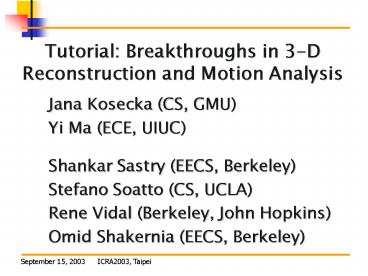Tutorial: Breakthroughs in 3-D Reconstruction and Motion Analysis - PowerPoint PPT Presentation
Title:
Tutorial: Breakthroughs in 3-D Reconstruction and Motion Analysis
Description:
Title: Slide 1 Author: Steve Overby Last modified by: yima Created Date: 1/26/2003 7:16:40 AM Document presentation format: On-screen Show Other titles – PowerPoint PPT presentation
Number of Views:119
Avg rating:3.0/5.0
Title: Tutorial: Breakthroughs in 3-D Reconstruction and Motion Analysis
1
Tutorial Breakthroughs in 3-D Reconstruction and
Motion Analysis
Jana Kosecka (CS, GMU) Yi Ma (ECE, UIUC) Shankar
Sastry (EECS, Berkeley) Stefano Soatto (CS,
UCLA) Rene Vidal (Berkeley, John Hopkins) Omid
Shakernia (EECS, Berkeley)
2
PRIMARY REFERENCE
3
Breakthroughs in 3D Reconstruction and Motion
Analysis
Lecture A Overview and Introduction
Yi Ma
Perception Decision Laboratory Decision
Control Group, CSL Image Formation Processing
Group, Beckman Electrical Computer Engineering
Dept., UIUC http//decision.csl.uiuc.edu/yima
4
TUTORIAL LECTURES
- A. Overview and introduction (Ma)
- B. Preliminaries geometry image formation (Ma)
- C. Image primitives correspondence (Kosecka)
- D. Two-view geometry (Kosecka)
- E. Uncalibrated geometry and stratification (Ma)
- F. Multiview recon. from points and lines
(Kosecka) - G. Reconstruction from scene knowledge (Ma)
- H. Step-by-step building of 3-D model (Kosecka)
- I. Landing of unmanned aerial vehicles (Kosecka)
- J. Multiple motion estimation (Ma)
5
TUTORIAL LOGICAL FLOW
IMAGING and VISION From 3D to 2D and then back
again
GEOMETRY FOR TWO VIEWS
GEOMETRY FOR MULTIPLE VIEWS
MULTIVIEW GEOMETRY WITH SYMMETRY
APPLICATIONS Image based modeling, vision based
control
6
Reconstruction from images The Fundamental
Problem
Input Corresponding features in multiple
perspective images. Output Camera pose,
calibration, scene structure representation.
7
Fundamental Problem An Anatomy of Cases
8
VISION AND GEOMETRY An uncanny deja vu?
The rise of projective geometry made such an
overwhelming impression on the geometers of the
first half of the nineteenth century that they
tried to fit all geometric considerations into
the projective scheme. ... The dictatorial
regime of the projective idea in geometry was
first successfully broken by the German
astronomer and geometer Mobius, but the
classical document of the democratic platform in
geometry establishing the group of
transformations as the ruling principle in any
kind of geometry and yielding equal rights to
independent consideration to each and any such
group, is F. Klein's Erlangen program.
-- Herman Weyl,
Classic Groups, 1952
Synonyms Group Symmetry
9
APPLICATIONS Autonomous Highway Vehicles
Image courtesy of California PATH
10
APPLICATIONS Unmanned Aerial Vehicles (UAVs)
Courtesy of Berkeley Robotics Lab
11
APPLICATIONS Real-Time Virtual Object Insertion
UCLA Vision Lab
12
APPLICATIONS Real-Time Sports Coverage
First-down line and virtual advertising
Courtesy of Princeton Video Image, Inc.
13
APPLICATIONS Image Based Modeling and Rendering
Image courtesy of Paul Debevec
14
APPLICATIONS Image Alignment, Mosaicing, and
Morphing
15
GENERAL STEPS Feature Selection and
Correspondence
- Small baselines versus large baselines
- Point features versus line features
16
GENERAL STEPS Structure and Motion Recovery
- Two views versus multiple views
- Discrete versus continuous motion
- General versus planar scene
- Calibrated versus uncalibrated camera
- One motion versus multiple motions
17
GENERAL STEPS Image Stratification and Dense
Matching
Left
Right
18
GENERAL STEPS 3-D Surface Model and Rendering
- Point clouds versus surfaces (level sets)
- Random shapes versus regular structures
19
Breakthroughs in 3D Reconstruction and Motion
Analysis
Lecture B Rigid-Body Motion and Imaging Geometry
Yi Ma
Perception Decision Laboratory Decision
Control Group, CSL Image Formation Processing
Group, Beckman Electrical Computer Engineering
Dept., UIUC http//decision.csl.uiuc.edu/yima
20
OUTLINE
- 3-D EUCLIDEAN SPACE RIGID-BODY MOTION
- Coordinates and coordinate frames
- Rigid-body motion and homogeneous
- coordinates
- GEOMETRIC MODELS OF IMAGE FORMATION
- Pinhole camera model
- CAMERA INTRINSIC PARAMETERS
- From metric to pixel coordinates
SUMMARY OF NOTATION
21
3-D EUCLIDEAN SPACE - Cartesian Coordinate Frame
22
3-D EUCLIDEAN SPACE - Vectors
A free vector is defined by a pair of points
23
3-D EUCLIDEAN SPACE Inner Product and Cross
Product
Inner product between two vectors
24
RIGID-BODY MOTION Rotation
Rotation matrix
25
RIGID-BODY MOTION Rotation and Translation
26
RIGID-BODY MOTION Homogeneous Coordinates
3-D coordinates are related by
27
IMAGE FORMATION Perspective Imaging
The Scholar of Athens, Raphael, 1518
Image courtesy of C. Taylor
28
IMAGE FORMATION Pinhole Camera Model
Pinhole
29
IMAGE FORMATION Pinhole Camera Model
2-D coordinates
30
CAMERA PARAMETERS Pixel Coordinates
31
CAMERA PARAMETERS Calibration Matrix and Camera
Model
Pinhole camera
Pixel coordinates
32
CAMERA PARAMETERS Radial Distortion
Nonlinear transformation along the radial
direction
Distortion correction make lines straight
33
IMAGE FORMATION Image of a Point
Homogeneous coordinates of a 3-D point
Homogeneous coordinates of its 2-D image
34
IMAGE FORMATION Image of a Line
Homogeneous representation of a 3-D line
35
SUMMARY OF NOTATION Multiple Images
.
.
.
- Images are all incident at the corresponding
features in space - Features in space have many types of incidence
relationships - Features in space have many types of metric
relationships.































